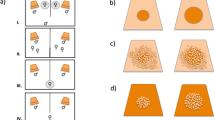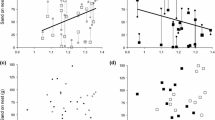Abstract
Nest quality is an important aspect of courtship and mate choice, offering females direct benefits through offspring survival and, if it reflects male genetic quality, also indirect ones. Nest characteristics may thus affect both male mating success and reproductive success. Using the sand goby, where males build nests by covering mussel shells or stones in sand, we tested the role of nest material in male nest site choice, nest construction, and female mate choice. We examined the effect of sand texture (coarse or fine, depending on grain size) in two different settings: (A) when the male was free to choose between nest sites in different sand textures and other males were absent, and (B) when the male was denied a choice of sand texture and another male was present behind a partition. In (B), we also examined the effects of sand texture on female preference. In (A), males took up nest sites equally often in coarse and fine sand, but nests built in fine sand had greater sand cover. In (B), there was no difference in nest sand cover, but a greater number of males, and in particular males that weighed less and had been assigned coarse sand, refrained from building a nest at all. This suggests that sand texture does affect nest building in sand gobies, manifesting itself directly through nest sand cover, or indirectly through failure to build a nest. Moreover, we found that females preferred to spawn in well-covered nests regardless of sand texture.
Significance statement
Nests offer eggs and offspring protection from predators and inclement weather, but building material may affect both the properties of the nest and the quality of the construction. Here, we presented male sand gobies with nest sites in either fine-grained or coarse-grained sand, assessed the sand cover of the nest, and allowed females to spawn. We found that grain size influenced the amount of sand cover on the nest and affected the fraction of males that refrained from building a nest. Female spawning decision depended on the amount of sand cover, but neither males nor females expressed a preference for sand texture. Our results show that nest material is an important but indirect aspect of mating success, which may influence habitat utilization in the wild.





Similar content being viewed by others
References
Barber I, Nairn D, Huntingford FA (2001) Nests as ornaments: revealing construction by male sticklebacks. Behav Ecol 12:390–396
Berson JD, Simmons LW (2018) Sexual selection across sensory modalities: female choice of male behavioral and gustatory displays. Behav Ecol 29:1096–1104
Borgia G (1985) Bower quality, number of decorations and mating success of male satin bowerbirds (Ptilonorhynchus violaceus): an experimental analysis. Anim Behav 33:266–271
Botero-Delgadillo E, Serrano D, Orellana N, Poblete Y, Vásquez RA (2017) Effects of temperature and time constraints on the seasonal variation in nest morphology of the thorn-tailed rayadito (Aphrastura spinicauda). Emu 117:181–187
Candolin U (2003) The use of multiple cues in mate choice. Biol Rev 78:575–595
Clarke A, Johnston NM (1999) Scaling of metabolic rate with body mass and temperature in teleost fish. J Anim Ecol 68:893–905
Dinno A (2017) conover.test: Conover-Iman test of multiple comparisons using rank sums. https://cran.r-project.org/package=conover.test
Forsgren E (1992) Predation risk affects mate choice in a gobiid fish. Am Nat 140:1041–1049
Forsgren E (1997a) Mate sampling in a population of sand gobies. Anim Behav 53:267–276
Forsgren E (1997b) Female sand gobies prefer good fathers over dominant males. Proc R Soc Lond B 264:1283–1286
Forsgren E (1999) Sexual selection and sex roles in the sand goby. In: Almada V, Oliveira R, Gonçalves E (eds) Behaviour and conservation of Littoral fishes. ISPA, Lisboa, pp 249–274
Forsgren E, Karlsson A, Kvarnemo C (1996) Female sand gobies gain direct benefits by choosing males with eggs in their nest. Behav Ecol Sociobiol 39:91–96
Hansell M (2000) Bird nests and construction behaviour. Cambridge University Press, Cambridge
Hess SE, Rohr S, Dufour BD, Gaskill BN, Pajor EA, Garner JP (2008) Home improvement: C57BL/6J mice given more naturalistic nesting materials build better nests. J Am Assoc Lab Anim Sci 47:25–31
Hesthagen I (1977) Migrations, breeding, and growth in Pomatoschistus minutus (Pallas) (Pisces, Gobiidae) in Oslofjorden, Norway. Sarsia 63:17–26
Hilton GM, Hansell MH, Ruxton GD, Reid JM, Monaghan P (2004) Using artificial nests to test importance of nesting material and nest shelter for incubation energetics. Auk 121:777–787
Hoi H, Schleicher B, Valera F (1994) Female mate choice and nest desertion in penduline tits, Remiz pendulinus: the importance of nest quality. Anim Behav 48:743–746
Japoshvili B, Lehtonen TK, Wong BBM, Lindström K (2012) Repeatability of nest size choice and nest building in sand gobies. Anim Behav 84:913–917
Jones JC, Reynolds JD (1999) Oxygen and the trade-off between egg ventilation and brood protection in the common goby. Behaviour 136:819–832
Kuznetsova A, Brockhoff PB, Christensen RHB (2017) lmerTest package: tests in linear mixed effects models. J Stat Softw 82:1–26
Kvarnemo C (1994) Temperature differentially affects male and female reproductive rates in the sand goby: consequences for operational sex ratio. Proc R Soc Lond B 256:151–156
Kvarnemo C, Forsgren E, Magnhagen C (1995) Effects of sex ratio on intra-and inter-sexual behaviour in sand gobies. Anim Behav 50:1455–1461
Lehtonen TK (2012) Signal value of male courtship effort in a fish with paternal care. Anim Behav 83:1153–1161
Lehtonen T, Lindström K (2004) Changes in sexual selection resulting from novel habitat use in the sand goby. Oikos 104:327–335
Lehtonen TK, Wong BB (2009) Should females prefer males with elaborate nests? Behav Ecol 20:1015–1019
Lehtonen TK, Rintakoski S, Lindström K (2007) Mate preference for multiple cues: interplay between male and nest size in the sand goby, Pomatoschistus minutus. Behav Ecol 18:696–700
Lehtonen TK, Lindström K, Wong BBM (2013) Effect of egg predator on nest choice and nest construction in sand gobies. Anim Behav 86:867–871
Lindström K, Ranta E (1992) Predation by birds affects population structure in breeding sand goby, Pomatoschistus minutus, males. Oikos 64:527–532
Lissåker M, Kvarnemo C (2006) Ventilation or nest defense - parental care trade-offs in a fish with male care. Behav Ecol Sociobiol 60:864–873
Lissåker M, Kvarnemo C, Svensson O (2003) Effects of a low oxygen environment on parental effort and filial cannibalism in the male sand goby, Pomatoschistus minutus. Behav Ecol 14:374–381
Mappes T, Mappes J, Kotiaho J (1994) Ectoparasites, nest site choice and breeding success in the pied flycatcher. Oecologia 98:147–149
McLaren P, Bowles D (1985) The effects of sediment transport on grain-size distributions. J Sediment Res 55:457–470
Miller PJ (1986) Fishes of the North-Eastern Atlantic and the Mediterranean. UNESCO, Paris
Møller AP, Linden M, Soler JJ, Soler M, Moreno J (1995) Morphological adaptations to an extreme sexual display, stone-carrying in the black wheatear, Oenanthe leucura. Behav Ecol 6:368–375
Mowles SL, Jennions MD, Backwell PR (2018) Robotic crabs reveal that female fiddler crabs are sensitive to changes in male display rate. Biol Lett 14:20170695
Oksanen J, Blanchet FG, Friendly M et al (2017) vegan: community ecology package. https://cran.r-project.org/package=vegan
Olsson KH, Kvarnemo C, Svensson O (2009) Relative costs of courtship behaviours in nest-building sand gobies. Anim Behav 77:541–546
Olsson KH, Kvarnemo C, Andrén MN, Larsson T (2016) Hypoxia increases the risk of egg predation in a nest-guarding fish. R Soc Open Sci 3:160326
Olsson KH, Johansson S, Blom E-L, Lindström K, Svensson O, Nilsson Sköld H,Kvarnemo C (2017) Dark eyes in female sand gobies indicate readiness to spawn. PLoS ONE 12:e0177714
Östlund-Nilsson S (2001) Fifteen-spined stickleback (Spinachia spinachia) females prefer males with more secretional threads in their nests: an honest-condition display by males. Behav Ecol Sociobiol 50:263–269
Östlund-Nilsson S, Holmlund M (2003) The artistic three-spined stickleback (Gasterosteous aculeatus). Behav Ecol Sociobiol 53:214–220
Pampoulie C, Lindström K, St. Mary CM (2004) Have your cake and eat it too: male sand gobies show more parental care in the presence of female partners. Behav Ecol 15:199–204
Quader S (2005) Elaborate nests in a weaverbird: a role for female choice? Ethology 111:1073–1088
R Core Team (2018) R: a language and environment for statistical computing. R Foundation for Statistical Computing, Vienna http://www.R-project.org
Raventos N (2006) Nest site characteristics and nesting success of the five-spotted wrasse Symphodus roissali in the north-western Mediterranean Sea. J Fish Biol 68:305–309
Rutnagur R (1990) Nest structure and related building behaviour in the rook Corvus frugilegus. Unpublished PhD thesis, Glasgow University
Scheipl F, Greven S, Kuechenhoff H (2008) Size and power of tests for a zero random effect variance or polynomial regression in additive and linear mixed models. Comput Stat Data Anal 52:3283–3299
Schindelin J, Arganda-Carreras I, Frise E, Kaynig V, Longair M, Pietzsch T, Preibisch S, Rueden C, Saalfeld S, Schmid B, Tinevez JY, White DJ, Hartenstein V, Eliceiri K, Tomancak P, Cardona A (2012) Fiji: an open-source platform for biological-image analysis. Nat Methods 9:676–682
Schneider CA, Rasband WS, Eliceiri KW (2012) NIH image to ImageJ: 25 years of image analysis. Nat Methods 9:671–675
SMHI (2017) Väderöarna WR Boj, https://www.smhi.se/klimatdata/oceanografi/ladda-ner-oceanografiska-observationer/#param=seatemperature,stations=all,stationid=33015. Accessed 28 Sep 2017
Soler JJ, Cuervo JJ, Møller AP, de Lope F (1998) Nest building is a sexually selected behaviour in the barn swallow. Anim Behav 56:1435–1442
Soler JJ, Ruiz-Castellano C, Figuerola J, Martín-Vivaldi M, Martínez-de la Puente J, Ruiz-Rodríguez M, Tomás G (2017) Telomere length and dynamics of spotless starling nestlings depend on nest-building materials used by parents. Anim Behav 126:89–100
Suárez-Rodríguez M, Macías Garcia C (2014) There is no such a thing as a free cigarette; lining nests with discarded butts brings short-term benefits, but causes toxic damage. J Evol Biol 27:2719–2726
Suárez-Rodríguez M, López-Rull I, Garcia CMÍ (2013) Incorporation of cigarette butts into nests reduces nest ectoparasite load in urban birds: new ingredients for an old recipe? Biol Lett 9:20120931
Svensson O, Kvarnemo C (2003) Sexually selected nest building - Pomatoschistus minutus males build smaller nest openings in the presence of sneaker males. J Evol Biol 16:896–902
Svensson O, Kvarnemo C (2005) The importance of sperm competition risk and nest appearance for male behavior and female choice in the sand goby, Pomatoschistus minutus. Behav Ecol 16:1042–1048
Tallmark B, Evans S (1986) Substrate-related differences in antipredator behaviour of two gobiid fish species and the brown shrimp, and their adaptive value. Mar Ecol Prog Ser 29:217–222
Wagner WE Jr, Reiser MG (2000) The importance of calling song and courtship song in female mate choice in the variable field cricket. Anim Behav 59:1219–1226
Acknowledgments
The authors thank Sofie Schöld at the Swedish Meteorological and Hydrological Institute for helping to locate relevant temperature data from institute databases. We also thank staff and colleagues at Sven Lovén Centre Kristineberg for use of facilities and support during the study and two anonymous reviewers for providing valuable comments on the manuscript.
Author information
Authors and Affiliations
Corresponding author
Ethics declarations
Conflict of interest
The authors declare that they have no conflict of interest.
Ethical approval
All applicable international, national, and/or institutional guidelines for the care and use of animals were followed. Ethical permission for the experimental procedures was obtained from the Swedish Animal Welfare Agency (dnr 211-2007) and University of Florida (UF IACUC #E644).
Additional information
Publisher’s note
Springer Nature remains neutral with regard to jurisdictional claims in published maps and institutional affiliations.
Communicated by J. Lindström
Rights and permissions
About this article
Cite this article
Olsson, K.H., Forsgren, E., Merilaita, S. et al. Effect of sand texture on nest quality and mating success in a fish with parental care. Behav Ecol Sociobiol 73, 96 (2019). https://doi.org/10.1007/s00265-019-2711-y
Received:
Revised:
Accepted:
Published:
DOI: https://doi.org/10.1007/s00265-019-2711-y




